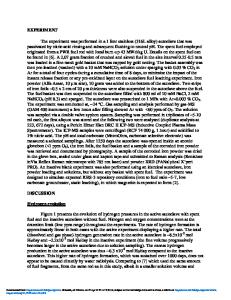Effect of Helium Accumulation on the Spent Fuel Microstructure
- PDF / 232,311 Bytes
- 6 Pages / 612 x 792 pts (letter) Page_size
- 46 Downloads / 382 Views
0985-NN05-01
Effect of Helium Accumulation on the Spent Fuel Microstructure Cecile Ferry1, Jean-Paul Piron2, and Ray Stout3 1 Department of Physico-chemistry, Commissariat ‡ l'Energie Atomique, CEA-Saclay, Gif-sur-Yvette, 91191, France 2 Commisariat ‡ l'Energie Atomique, CEA - Cadarache, Saint-Paul Lez Durance, 13108, France 3 Rho Beta Sigma Affaires, Livermore, CA, CA 94550 ABSTRACT In a nuclear spent fuel repository, the aqueous rapid release of radio-activity from exposed spent fuel surfaces will depend on the pellet microstructure at the arrival time of water into the disposal container. Research performed on spent fuel evolution in a closed system has shown that the evolution of microstructure under disposal conditions should be governed by the cumulated α−decay damage and the subsequent helium behavior. The evolution of fission gas bubble characteristics under repository conditions has to be assessed. In UO2 fuels with a burnup of 47.5 GWd/t, the pressure in fission gas bubbles, including the pressure increase from α−decay helium atoms, is not expected to reach the critical bubble pressure that will cause failure, thus micro-cracking in UO2 spent fuel grains is not expected. INTRODUCTION The rapid release of activity when water initially contacts the spent fuel (SF) surface during disposal will depend on the pellet microstructure at the time of water arrival in the container. Research performed on spent fuel evolution in a closed system has shown that the evolution of pellet microstructure is governed by the cumulated α−decay helium damage [1]. However, the fate of helium atoms in the spent fuel remains to be assessed. The behaviour of fission gases (FG) in the fuel rod during irradiation in reactor has been widely studied and is relatively well known. A comparison between in-reactor and out-ofreactor conditions identifies potential mechanisms governing helium behaviour in the spent fuel rod under repository conditions. The potential evolution of FG intra-granular bubbles due to helium accumulation and bubble gas pressure conditions for rupture of grains before helium release into grain boundaries will be discussed. FATE OF HELIUM IN SPENT FUEL UNDER REPOSITORY CONDITIONS The mechanisms by which fission gases are released into the free volume of a fuel rod and the subsequent impact on the thermo-mechanical behavior of the fuel rod have been widely discussed in the literature, [e.g., 2]. The potential mechanism that may govern helium release in a spent fuel rod has been assessed in regards to the different mechanisms proposed for fission gas conditions in-reactor and helium conditions in out-of-reactor spent fuel. The main differences are listed in Table I. It indicates that helium atoms should firstly precipitate as nanometer
Table I. Comparison between in- and out-of reactor conditions In-reactor conditions
Out-of-reactor conditions
Short time (a few years) and high temperature (400 to 1200∞C)
Long time (10,000 years) and low temperature (T < 200∞C)
High fission gas atom rate (typical ≈ 3 ◊ 1018 at.m-3
Data Loading...











